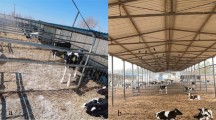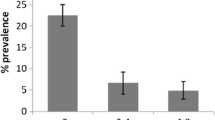Abstract
Cryptosporidium parvum is a well-known intestinal parasite which is associated with severe acute diarrhea in humans and animals. This parasite is composed of morphologically identical but genetically different multiple genotypes. In humans, cryptosporidiosis is mainly caused by two C. parvum genotypes, human genotype (previously known as genotype 1 and recently proposed as new species C. hominis) and cattle genotype (previously known as genotype 2). However, recent molecular studies indicate the genetic heterogeneity among the isolates of C. parvum human or cattle genotype. Therefore, identification of the isolates at the subgenotype level is more useful for control of the Cryptosporidium infection or for understanding of the population structure of C. parvum genotypes. In the present study, we identified the subgenotypes of the C. parvum human or cattle genotype isolates from humans and animals in Japan using DNA sequencing analysis of the C. parvum 60-kDa glycoprotein gene (GP60) and showed the new subgenotype in a raccoon dog isolate. This study suggested that C. parvum cattle genotype might be composed of zoonotic and host-specific multiple subgenotypes.

Similar content being viewed by others
References
Abe N, Kimata I, Iseki M (2002) Identification of genotypes of Cryptosporidium parvum isolates from a patient and a dog in Japan. J Vet Med Sci 64:165–168
Abe N, Nakamura S, Kimata I (2005) An imported case of mixed infection by Giardia and Cryptosporidium parasites in Japan. Seikatsu Eisei 49:48–51
Alves M, Xiao L, Sulaiman I, Lal AA, Matos O, Antunes F (2003) Subgenotype analysis of Cryptosporidium isolates from humans, cattle, and zoo ruminants in Portugal. J Clin Microbiol 41:2744–2747
Leav BA, Mackay MR, Anyanwu A, O’Connor RM, Cevallos AM, Kindra G, Rollins NC, Bennish ML, Nelson RG, Ward HD (2002) Analysis of sequence diversity at the highly polymorphic Cpgp40/15 locus among Cryptosporidium isolates from human immunodeficiency virus-infected children in South Africa. Infect Immun 70:3881–3890
Matsubayashi M, Abe N, Takami K, Kimata I, Iseki M, Nakanishi T, Tani H, Sasai K, Baba E (2004) First record of Cryptosporidium infection in a raccoon dog (Nyctereutes procyonoides viverrinus). Vet Parasitol 120:171–175
Peng M, Matos O, Gatei W, Das P, Stantic-Pavlinic M, Bern C, Sulaiman IM, Glaberman S, Lal AA, Xiao L (2001) A comparison of Cryptosporidium subgenotypes from several geographic regions. J Eukaryot Microbiol 2001 (Suppl.):28S–31S
Peng MM, Meshnick SR, Cunliffe NA, Thindwa BDM, Hart CA, Broadhead RL, Xiao L (2003) Molecular epidemiology of cryptosporidiosis in children in Malawi. J Eukaryot Microbiol 50:557–559
Sulaiman IM, Hira PR, Zhou L, Al-Ali FM, Al-Shelahi FA, Shweiki HM, Iqbal J, Khalid N, Xiao L (2005) Unique endemicity of cryptosporidiosis in children in Kuwait. J Clin Microbiol 43:2805–2809
Wu Z, Nagano I, Boonmars T, Nakada T, Takahashi Y (2003) Intraspecies polymorphism of Cryptosporidium parvum revealed by PCR-restriction fragment length polymorphism (RFLP) and RFLP-single-strand conformational polymorphism analyses. Appl Environ Microbiol 69:4720–4726
Xiao L, Morgan UM, Limor J, Escalante A, Arrowood M, Shulaw W, Thompson RC, Fayer R, Lal AA (1999) Genetic diversity within Cryptosporidium parvum and related Cryptosporidium species. Appl Environ Microbiol 65:3386–3391
Xiao L, Limor J, Morgan UM, Sulaiman IM, Thompson RC, Lal AA (2000) Sequence differences in the diagnostic target region of the oocyst wall protein gene of Cryptosporidium parasites. Appl Environ Microbiol 66:5499–5502
Xiao L, Ryan UM (2004) Cryptosporidiosis: an update in molecular epidemiology. Curr Opin Infect Dis 17:483–490
Author information
Authors and Affiliations
Corresponding author
Rights and permissions
About this article
Cite this article
Abe, N., Matsubayashi, M., Kimata, I. et al. Subgenotype analysis of Cryptosporidium parvum isolates from humans and animals in Japan using the 60-kDa glycoprotein gene sequences. Parasitol Res 99, 303–305 (2006). https://doi.org/10.1007/s00436-006-0140-0
Received:
Accepted:
Published:
Issue Date:
DOI: https://doi.org/10.1007/s00436-006-0140-0




